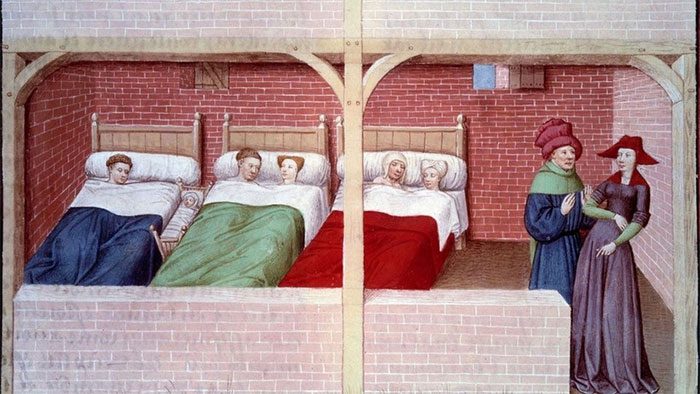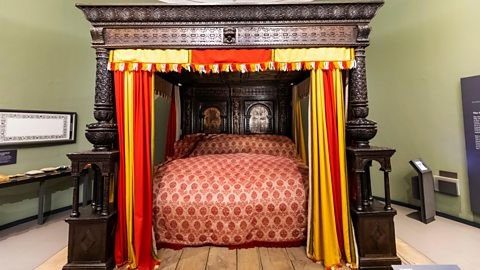Until the mid-19th century, in Europe, sharing a bed with others, even strangers, was commonly seen as normal and widespread.
Queen Elizabeth I of England, despite never marrying, never slept alone during her 44 years of reign.
Sleeping is Just Sleeping

Before 1861, communal sleeping was a daily occurrence. (Image: BBC.com)
According to English history, in 1187, Emperor Richard I (1157 – 1199), who was a notorious military leader on the battlefield, requested to share a bed with Emperor Philip II of France, who had unexpectedly turned from foe to friend.
Initially, the meeting between Richard I and Philip II was purely political. England and France sought to forge an alliance instead of waging war against each other, forcing them to become friends.
However, after spending time together and sharing meals, Richard I and Philip II grew increasingly close, and ultimately, as a way to prove their friendship, they slept side by side in one bed.
For Westerners in ancient and medieval times, sharing a bed was commonplace. Friends, family, colleagues, and even strangers shared beds.
The common people slept together due to a lack of beds, while the nobility did so to be close to loved ones for conversation. Additionally, sharing a bed was also a solution to combat the cold and seek a sense of safety.
“It would be unusual for someone to sleep alone,” states the author of the book At Day’s Close: A History of Nighttime. In the 1590s, a small town in Hertfordshire became famous for its giant oak furniture.
This was the “Great Bed”, which stood 2.7 meters high, 3.3 meters wide, and 3.4 meters long, allowing multiple guests, often four couples, to sleep together. For centuries, it attracted visitors, including the greatest playwright of all time, William Shakespeare (1564 – 1616). According to legend, the bed’s record was set in 1689 when 26 couples (52 people) who were butchers slept together for one night.
Unlike the word “sleep” today, which carries a “dark” connotation, sleeping together at that time simply meant biological sleep. Communal sleeping was simply many people sharing a bed to fall into a deep slumber.
On a positive note, it helped break down class barriers. Thanks to the custom of sharing beds, teachers and students, masters and servants, generals and soldiers… could share nights without hierarchy.

The famous “Great Bed” mentioned by Shakespeare. (Image: BBC.com).
Inconveniences and Disappearance
Some medieval documents state that sharing a bed was very beneficial. The diary of British naval officer Samuel Pepys (1633 – 1703) recounts an occasion when Pepys shared a bed with a doctor from the Royal Society in London. While Pepys could not sleep due to flea bites, the doctor snored loudly because the fleas preferred Pepys’s blood over his.
Queen Elizabeth I (1533 – 1603) had many beds. Throughout her life, she never married but was always surrounded by her trusted maids of honor. Every night, these maids would take turns sleeping alongside the queen.
In addition to protecting the queen, they also served as confidantes, helping her shed the burdens of ruling and drift into a peaceful sleep.
Not only Queen Elizabeth I but many common women found a sense of safety and deep sleep beside their sisters and friends. In the evenings, they would chat until sleep overtook them. In the morning, they would share their dreams from the night before and eagerly interpret them together.
However, sleeping together was not without its drawbacks. Late on the night of September 9, 1776, two Founding Fathers of America, Benjamin Franklin (1706 – 1790) and John Adams (1735 – 1826), had a heated argument over whether to open or close the window. According to reports, Franklin suggested opening it for ventilation, while Adams wanted to close it to keep warm. Their exchange escalated into a loud quarrel.
Communal sleeping could be even more troublesome because of differing habits. Moreover, not everyone maintained cleanliness. When men and women shared a space, even with many others present, there were times when things could turn “heated. ”
In the early 19th century, families in Ireland established sleeping arrangements where the eldest daughter slept against the wall opposite the entrance, followed by younger daughters in order of age, then the parents, sons (also in order of age), and finally guests.
In noble families, having male and female servants sleep together due to a lack of beds sometimes led to female servants becoming “unexpectedly pregnant.” Sharing a bed with strangers occasionally posed risks of sexual violence, robbery, and theft.
In the opening chapter of the classic novel Moby Dick (1851), author Herman Melville (1819 – 1891) created a scenario where a tavern had only one bed available. The protagonist found himself in a situation where he had to share a bed with an unknown whaler, leaving him feeling uneasy and fearing for his safety.
Above all, communal sleeping was a breeding ground for disease. Given the limited hygiene standards of the medieval period, shared beds were often infested with fleas, lice, mold… and of course, posed numerous health risks. By the mid-19th century, the West ceased to view “sleeping alone as unusual.” Even couples began to prefer sleeping separately for a better rest.
In 1861, influential American physician William Whitty Hall (1810 – 1876) published a book that ended communal sleeping: Sleep. He condemned communal sleeping for robbing people of privacy, mutual respect, hygiene, and morality, even going so far as to claim it made people “no different than animals.” Due to his influence, for a century, Europeans sought various ways to sleep alone. It wasn’t until the 1950s that this trend began to reverse.
Today, most people prefer to sleep alone. Each person has their own reasons, but ultimately, it is for the sake of sleep health.
Although communal sleeping is filled with inconveniences, it also has its benefits. Richard I and Philip II are proof of this. Once you overcome your apprehensions, what lies behind is all comfort and security. Sharing a bed with one or more people can indeed be beneficial, just as people in the past recognized.




















































